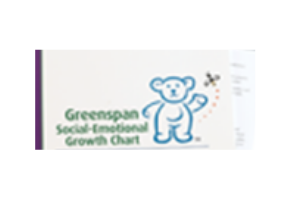Description
Greenspan Social-Emotional Growth Chart monitors the milestones of social-emotional development in infants and young children. Early identification of social-emotional deficits and compromises leads to more successful interventions.

Greenspan Social-Emotional Growth Chart monitors the milestones of social-emotional development in infants and young children. Early identification of social-emotional deficits and compromises leads to more successful interventions.
Greenspan Social-Emotional Growth Chart monitors the milestones of social-emotional development in infants and young children. Early identification of social-emotional deficits and compromises leads to more successful interventions.
Stanley Greenspan
Overview:Monitor the milestones of social-emotional development in infants and very young children
Age Range:0-42 months (Items are presented according to age typical of mastery.)
Completion Time:10 minutes
Publication Date:Fall 2004
Stanley Greenspan, M.D., one of the world’s leading experts in child development, has developed a screening tool to measure social-emotional milestones in young children ages 0 to 42 months. Early identification of social-emotional deficits and compromises leads to more successful interventions.
Greenspan Social-Emotional Growth Chart offers a brief and reliable tool to meet your needs:
Greenspan Social-Emotional Growth Chart is a questionnaire completed by the child’s parent, educator, or other caregiver to understand how the child uses all capacities to meet needs, deal with feelings, think, and communicate. The questionnaire has the following characteristics:
The Greenspan Social-Emotional Growth Chart should be given as a preliminary step in childcare screenings, early identification screenings, and pediatric screenings. It should be used to determine whether further assessment/referral is warranted and can assist in monitoring growth and planning intervention.
Frequently asked questions follow. Click on a question to see the response.
If the Social-Emotional Scale on the Bayley–III is the same as the Greenspan Social-Emotional Growth Chart, why are there different scores available for the two instruments?
Scoring
What is the difference between rating an item as Can’t Tell (score = 0) and None of the Time (score = 1) for the Social-Emotional Scale?
Where can I find more information on interpreting scores for the Social-Emotional Scale?
When completing the Greenspan Social-Emotional Growth Chart, sometimes the Highest Stage Mastered for a child can be a full stage below what is expected for his or her age, but the Growth Chart Index score indicates Full Mastery. Isn’t this contradictory?When completing the Greenspan Social-Emotional Growth Chart, sometimes the Highest Stage Mastered for a child can be a full stage below what is expected for his or her age, but the Growth Chart Index score indicates Full Mastery. Isn’t this contradictory?
When calculating the chronological age, should I round days to the nearest month?